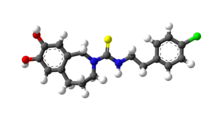Capsazepine

| |

| |
| Names | |
|---|---|
| IUPAC name
N-[2-(4-Chlorophenyl)ethyl]-1,3,4,5-
tetrahydro-7,8-dihydroxy-2H-2- benzazepine-2-carbothioamide | |
| Identifiers | |
3D model (JSmol)
|
|
| ChEMBL | |
| ChemSpider | |
PubChem CID
|
|
| UNII | |
CompTox Dashboard (EPA)
|
|
| |
| |
| Properties | |
| C19H21ClN2O2S | |
| Molar mass | 376.9 g/mol |
Except where otherwise noted, data are given for materials in their standard state (at 25 °C [77 °F], 100 kPa).
| |
Capsazepine is a synthetic analogue of capsaicin.
Pharmacology
Capsazepine blocks the painful sensation of heat caused by capsaicin (the active ingredient of chilli pepper) which activates the TRPV1 ion channel. It is therefore considered to be a TRPV1 antagonist. The TRPV1 channel functions as a pain and temperature sensor in mammalians. Capsazepine blocks only the activation of TRPV1 channels by chemicals but not by other painful stimuli, like heat. Depending on the pharmacological assay the half maximal inhibitory concentration IC50 is in the nanomolar to low micromolar range. In addition to its effects on TRPV1 channels it was also shown to inhibit the cold activated TRPM8 channel,[1] voltage-activated calcium channels[2] and nicotinic acetylcholine receptors.[3] It mainly serves as a tool to study the TRPV1 ion channel.[4]
Development
Capsazepine was discovered by a research group at the Sandoz Institute for Medical Research. Its synthesis and chemical properties were published in 1994. It was found by modification of the chemical backbone of capsaicin.[5]
Recent Developments
By incorporation of an azobenzene unit, a photoswitchable version of capsazepine (AC4) was developed in 2013 that allows for optical control of TRPV1 channels with light.[6]
See also
External links
References
- ^ Behrendt HJ, Germann T, Gillen C, Hatt H, Jostock R (February 2004). "Characterization of the mouse cold-menthol receptor TRPM8 and vanilloid receptor type-1 VR1 using a fluorometric imaging plate reader (FLIPR) assay". Br. J. Pharmacol. 141 (4): 737–45. doi:10.1038/sj.bjp.0705652. PMC 1574235. PMID 14757700.
- ^ Docherty RJ, Yeats JC, Piper AS (August 1997). "Capsazepine block of voltage-activated calcium channels in adult rat dorsal root ganglion neurones in culture". British Journal of Pharmacology. 121 (7): 1461–7. doi:10.1038/sj.bjp.0701272. PMC 1564831. PMID 9257928.
- ^ Liu L, Simon SA (May 1997). "Capsazepine, a vanilloid receptor antagonist, inhibits nicotinic acetylcholine receptors in rat trigeminal ganglia". Neuroscience Letters. 228 (1): 29–32. doi:10.1016/S0304-3940(97)00358-3. PMID 9197280.
- ^ Valenzano KJ, Sun Q (December 2004). "Current perspectives on the therapeutic utility of VR1 antagonists". Current medicinal chemistry. 11 (24): 3185–202. doi:10.2174/0929867043363686. PMID 15579007.[permanent dead link]
- ^ Walpole CS, Bevan S, Bovermann G, et al. (June 1994). "The discovery of capsazepine, the first competitive antagonist of the sensory neuron excitants capsaicin and resiniferatoxin". Journal of Medicinal Chemistry. 37 (13): 1942–54. doi:10.1021/jm00039a006. PMID 8027976.
- ^ Stein M; et al. (July 2013). "Optical Control of TRPV1 Channels". Angewandte Chemie International Edition. ahead of print (37): 9845–8. doi:10.1002/anie.201302530. PMID 23873837.
